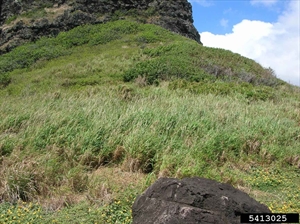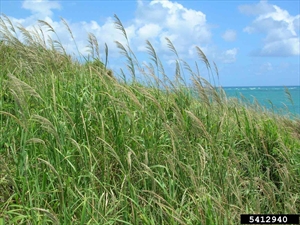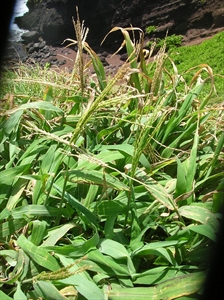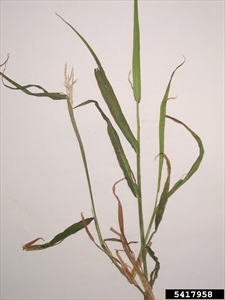- Worldwide distribution. In Fiji, Guam, Marshall Islands, Northern Mariana Islands, Papua New Guinea, Solomon Islands, Vanuatu.
- Invasive grass of disturbed habitats, invasive where native as well as introduced, forming dense stands in wastelands, roadsides, abandoned fields, pastures, forests, crops (citrus, coffee, cotton, forest nurseries, maize, pineapple, tea). Host of maize viruses. Threat to native grasses (Hawaii).
- Erect, up to 1.5m; stems from short swollen rhizomes, and branching from lower and middle nodes. Leaves up to 40cm, edges rough, sheaths hairy, ligule 3-4mm. Flower clusters whitish, slender up to 30cm, with up to 50 branches, each with paired spikelets, containing the flowers (florets).
- Spread: seed on the wind, rhizomes; over long distances on clothing, machinery, vehicles, contaminant of pasture species.
- Biosecurity: check seeds of other species.
- Biocontrol: none.
- Cultural control: remove seedlings. Replace with competing grasses (buffel or Guinea). Clean machinery/vehicles.
- Chemical control: glyphosate; if resistant, use fluazifop or nicosulfuron, depending on crop.
Pacific Pests, Pathogens and Weeds - Online edition
Pacific Pests, Pathogens, Weeds & Pesticides
Sourgrass (498)
Sourgrass. It is also known as cotton grass, feather-top grass.
Digitaria insularis; previously, it was known as Trichachne insularis. It is a member of the Poaceae.
AUTHOR Grahame Jackson
Information from PIER (2013) Digitaria insularis (L.) Mez ex Ekman, Poaceae. Pacific Island Ecosystems at Risk (PIER), Institute of Pacific Islands Forestry. (http://www.hear.org/pier/species/hyptis_capitata.htm); and CABI (2019) Digitaria insularis (sourgrass). Invasive Species Compendium. (https://www.cabi.org/isc/datasheet/109596); and from Chris Brodie (2020) Weeds Australia - Profiles. Centre for Invasive Species Solutions, Department of Agriculture, Water and the Environment. Australian Government. (https://profiles.ala.org.au/opus/weeds-australia/profile/Digitaria%20insularis). Photos 1-4 Forrest & Kim Starr, Starr Environmental, Bugwood.org.
Produced with support from the Australian Centre for International Agricultural Research under project HORT/2016/185: Responding to emerging pest and disease threats to horticulture in the Pacific islands, implemented by the University of Queensland and the Secretariat of the Pacific Community.







